Colony of Singapore
British Singapore or simply Singapore was a crown colony of the United Kingdom from 1946 to 1963. When the Empire of Japan surrendered to the Allies at the end of World War II, Singapore was returned to the British in 1945, having controlled the territory since 1819 as part of the Straits Settlements. In 1946, the latter were dissolved and Singapore together with the Cocos-Keeling and Christmas Island (now under Australia) became a separate crown colony.[4] The colony was governed directly from London until it gained partial internal self-governance in 1955.[5]
Singapore | |
|---|---|
| 1946–1963 | |
.svg.png) | |
| Status | Crown colony |
| Capital and largest city | Singapore (city-state) 1°17′N 103°50′E |
| Official language and national language | English |
| Common languages | Chinese, Japanese, Malay, Tamil |
| Government | Constitutional monarchy |
| Monarch | |
• 1946–1952 | George VI |
• 1952–1963 | Elizabeth II |
| Governor | |
• 1946–1952 (first) | Sir Franklin Charles Gimson |
• 1957–1959 (last) | Sir William Goode |
| Chief Minister / Prime Minister | |
• 1955–1956 | David Marshall |
• 1956–1959 | Lim Yew Hock |
• 1959–1963 | Lee Kuan Yew |
| Legislature | Legislative Council of Singapore |
| Historical era | British Empire |
• Dissolution of the Straits Settlements | 1 April 1946 |
| 15 July 1946 | |
| 23 November 1955 | |
• Christmas Island transferred to Australia | 1 October 1958 |
• Autonomy within the British Empire | 1959 |
• Merger with the Federation of Malaysia | 16 September 1963 |
| Area | |
| 1963[2] | 670 km2 (260 sq mi) |
| Population | |
• 1963[3] | 1,795,000 |
| Currency |
|
| Time zone | UTC+07:30 (Singapore Standard Time (SST)) |
| Driving side | left |
| ISO 3166 code | SG |
| Today part of | |
Part of a series on the |
||||||||||||||||||||||
|---|---|---|---|---|---|---|---|---|---|---|---|---|---|---|---|---|---|---|---|---|---|---|
| History of Singapore | ||||||||||||||||||||||
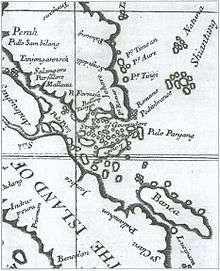 | ||||||||||||||||||||||
|
Early history (pre-1819)
|
||||||||||||||||||||||
|
British colonial era (1819–1942)
|
||||||||||||||||||||||
|
Japanese Occupation (1942–1945)
|
||||||||||||||||||||||
|
Post-war period (1945–1962)
|
||||||||||||||||||||||
|
Internal self-government (1955–1963)
|
||||||||||||||||||||||
|
Merger with Malaysia (1963–1965) |
||||||||||||||||||||||
|
Republic of Singapore (1965–present)
|
||||||||||||||||||||||
|
| ||||||||||||||||||||||
History
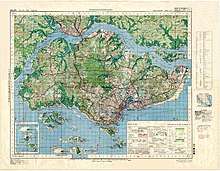
Post war period: return of British rule
After Japan surrendered to the Allies on 15 August 1945, there was a state of anomie in Singapore, as the British had not arrived to take control, while the Japanese occupiers had a considerably weakened hold over the populace. Incidents of looting and revenge-killing were widespread.
When British troops returned to Singapore in September 1945, thousands of Singaporeans lined the streets to cheer them. Singapore was ruled by a British Military Administration (BMA) between September 1945 and March 1946, during which it also served as the headquarters of the British governor-general for Southeast Asia. However much of the infrastructure had been destroyed, including electricity and water supply systems, telephone services, as well as the harbour facilities at the Port of Singapore.[6]
There was also a shortage of food including rice, and this led to malnutrition, disease, and rampant crimes and violence. Unemployment, high food prices, and workers' discontent culminated in a series of strikes in 1947 causing massive stoppages in public transport and other services. By late 1947, the economy began to recover, facilitated by the growing demand for tin and rubber around the world. But it would take several more years before the economy returned to pre-war levels.[6]
Establishment of the colony
On 1 April 1946, the Straits Settlements was dissolved and Singapore became a Crown Colony with a civil administration headed by a Governor and separated from peninsular Malaya. In July 1947, separate Executive and Legislative Councils were established and provisions were made to allow for the election of six members of the Legislative Council the next year.[7] On 30 November 1959, the Singapore State Arms and Flag and National Anthem Ordinance 1959 was passed to regulate the use and display of the State Arms and State Flag and the performance of the National Anthem.[8]
Merger with Malaysia
The failure of the British to defend Singapore had destroyed their credibility as infallible rulers in the eyes of the locals in Singapore. The decades after and during the war saw a political awakening amongst the local populace and the rise of nationalist and anti-colonial sentiments, including a cry for Merdeka, roughly translated to "independence" in the Malay language. The British, on their part, were prepared to embark on a program of gradually increasing self-governance for Singapore and Malaya.[6] The Crown colony was dissolved on 16 September 1963 when Singapore became a state of Malaysia, ending 144 years' of British rule on the island.
On 9 August 1965, Singapore officially left Malaysia to become the independent Republic of Singapore, due to political, economic and racial disputes.
Government
First Legislative Council (1948–1951)
The first Singaporean elections, held in March 1948 to select members of the Legislative Council, were rather limited. The right to vote was restricted to adult British subjects, of which only 23,000 or about 10 percent of those eligible registered to vote. In addition, only six of the twenty-five seats on the Legislative Council were to be elected; the rest were chosen either by the Governor or by the chambers of commerce.[6]
Three of the elected seats were won by a newly formed Singapore Progressive Party (SPP), a conservative party whose leaders were businessmen and professionals and were disinclined to press for immediate self-rule. The other three seats were won by independents.
Three months after the elections, an armed insurgency by communist groups in Malaya – the Malayan Emergency – broke out, and the British imposed harsh measures to control left-wing groups in both Singapore and Malaya; the controversial Internal Security Act, which allowed indefinite detention without trial for persons suspected of being "threats to security", was introduced at this time.[6]
Since the left-wing groups were the strongest critics of the colonial system, progress on self-government stalled for several years. The colonial government also tried to prevent contacts between Singaporean Chinese and China, which had just fallen under the rule of the Communist Party of China. Tan Kah Kee, a local businessman and philanthropist, was denied re-entry into Singapore after he made a trip to China.[6]
Second Legislative Council (1951–1955)
A second Legislative Council election was held in 1951 with the number of elected seats increased to nine. This election was again dominated by the SPP which won six seats. This slowly contributed to the formation of a distinct government of Singapore, although colonial administration was still dominant.
In 1953, with the communists in Malaya suppressed and the worst of the 'Emergency' period over, the government appointed a commission, headed by Sir George Rendel, to study the possibility of self-government for Singapore. The commission proposed a limited form of self-government.
The Legislative Assembly with twenty-five out of thirty-two seats chosen by popular election would replace the Legislative Council, from which a Chief Minister as head of government and Council of Ministers as a cabinet would be picked under a parliamentary system. The British would retain control over areas such as internal security and foreign affairs, as well as veto power over legislation.
The government agreed with the recommendations, and Legislative Assembly elections were scheduled for 2 April 1955. The election was a lively and closely fought affair, with several newly formed political parties joining the fray. In contrast to previous elections, voters were automatically registered, expanding the electorate to around 300,000. The SPP was soundly defeated in the election, winning only four seats. The newly formed, left-leaning Labour Front was the largest winner with ten seats and was able to form a coalition government with the UMNO-MCA Alliance, which won three seats.[6] Another new party, the then leftist People's Action Party (PAP), won three seats.
Administration
On 1 April 1946, the colony of Singapore was formed with Cocos-Keeling, Christmas Island after the dissolution of the Straits Settlement. As a Crown colony, Singapore inherited the hierarchical organisational structure of the Straits Settlements government with a governor, who was assisted by an Advisory Executive Council, a Legislative Council and a Municipal Council.[9] In July 1946, Labuan became part of the Crown Colony of North Borneo.[10][11] The sovereignty of the Cocos (Keeling) Islands was transferred to Australia in 1955. The administration of Christmas Island was also transferred to Australia in 1957.
Governors of Singapore (1946–1959)
The Governors of Singapore ruled Singapore. The men that held this position governed the Crown Colony of Singapore from 1946 to 1959, on behalf of the Colonial Office until Singapore gained self-governance in 1959 in where the Office of the Governor was abolished.
| # | Governor of Singapore | Term of office | ||
|---|---|---|---|---|
| Took office | Left office | |||
| 1 | 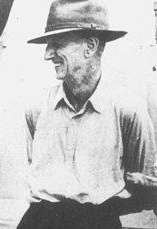 | Sir Franklin Charles Gimson, KCMG KStJ | 1 April 1946 | 20 March 1952 |
| – | 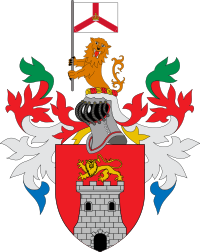 | Wilfred Lawson Blythe, CMG (Acting) | 20 March 1952 | 1 April 1952 |
| 2 |  | Sir John Fearns Nicoll, KCMG KStJ | 21 April 1952 | 2 June 1955 |
| – |  | Sir William Goode, GCMG KStJ (Acting) | 2 June 1955 | 30 June 1955 |
| 3 |  | Sir Robert Brown Black, GCMG OBE | 30 June 1955 | 9 December 1957 |
| 4 |  | Sir William Goode, GCMG, KStJ | 9 December 1957 | 3 June 1959 |
- Bose, Romen, "THE END OF THE WAR: The Liberation of Singapore and the aftermath of the Second World War", Marshall Cavendish, Singapore, 2005
Notes
- There is no authorised version of the national anthem as the words are a matter of tradition; only the first verse is usually sung.[1] No law was passed making "God Save the Queen" the official anthem. In the English tradition, such laws are not necessary; proclamation and usage are sufficient to make it the national anthem. "God Save the Queen" also serves as the Royal anthem for certain Commonwealth realms. The words Queen, she, her, used at present (in the reign of Elizabeth II), are replaced by King, he, him when the monarch is male.
References
- "National Anthem". Official web site of the British Royal Family. 15 January 2016. Retrieved 4 June 2016.
- "Singapore - Land area". Index Mundi. Retrieved 27 August 2016.
- "Singapore - Land area". Index Mundi. Retrieved 27 August 2016.
- Colony of Singapore. Government Gazette. (1946, April 1). The Singapore Colony Order in Council, 1946 (G.N. 2, pp. 2–3). Singapore: [s.n.]. Call no.: RCLOS 959.57 SGG; White paper on Malaya (1946, January 26). The Straits Times, p. 2. Retrieved from NewspaperSG; Tan, K. Y. L. (Ed.). (1999). The Singapore legal system (pp. 232–233). Singapore: Singapore University Press. Call no.: RSING 349.5957 SIN.
- "Singapore : History | The Commonwealth". thecommonwealth.org. Archived from the original on 9 September 2019. Retrieved 6 May 2019.
- "Singapore – Aftermath of War". U.S. Library of Congress. Retrieved 18 June 2006.
- "Towards Self-government". Ministry of Information, Communications and the Arts, Singapore. Archived from the original on 13 July 2006. Retrieved 18 June 2006.|
- Singapore State Arms and Flag and National Anthem Ordinance 1959 (No. 70 of 1959), now the Singapore Arms and Flag and National Anthem Act (Cap. 296, 1985 Rev. Ed.).
- Electoral representation for the new Singapore Council. (1946, April 2). The Straits Times, p. 2. Retrieved from NewspaperSG; Tan, T. Y. L. (1999). The Singapore legal system (pp. 40–42). Singapore: Singapore University Press. Call no.: RSING 349.5957 SIN.
- "NORTH BORNEO JOINS EMPIRE". The Straits Times. 16 July 1946. p. 1.
- "N. BORNEO BECOMES A COLONY". The Singapore Free Press and Daily News. 16 July 1946. p. 5.
.svg.png)

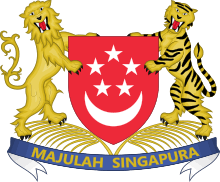
.svg.png)